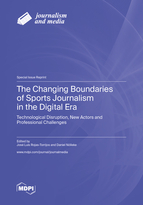The Changing Boundaries of Sports Journalism in the Digital Era: Technological Disruption, New Actors and Professional Challenges
A special issue of Journalism and Media (ISSN 2673-5172).
Deadline for manuscript submissions: closed (31 January 2023) | Viewed by 32237
Special Issue Editors
Interests: journalism; sports journalism; online journalism; innovation in journalism; media ethics and accountability
Special Issue Information
Dear Colleagues,
The boundaries of sports journalism continue to expand as non-traditional actors emerge and proliferate in the digital environment. This outstanding and vital specialist area of work within the news industry faces increasing pressure from adjacent fields. Amateur sports enthusiasts (bloggers, streamers or influencers) and team media for sports organisations adopt many of the roles and tasks historically attributed to sports journalism and engage in activities that may be perceived and regarded as journalistic by audiences.
As Simon McEnnis points out in his book Disrupting Sports Journalism (2021), “sports journalists are seeing how the very bases of their professional practice are being appropriated by others” and, yet at the same time, they are trying to defend their distinctiveness by elevating their standing and professional status.
The arrival of new actors around the journalistic field, the heavy use of social media and its impact on sports consumption patterns, as well as the search for new business models for news organisations and the disrupting technology that is being explored and applied as innovation in the sports coverage all require new conceptual approaches to better understand the sports newswork in the digital age.
All of these considerations lead this Special Issue to reopen and broaden the discussion among scholars about the current trends in the sports media landscape and the bigger challenges that sports journalists need to face in the coming years.
These are the topics to be addressed in this Special Issue of Journalism and Media:
- Theoretical considerations of professionalism in sports journalism;
- Sports journalism and its boundaries: from bloggers to team media for sports organizations;
- Disrupting technologies, new job profiles and practices in digital sports newsrooms;
- The heavy use of social media and the reshaping of the sports news agenda;
- Audiences' consumption habits and perceptions in the era of attention economy;
- Sports events, TV networks and streaming platforms;
- Esports and other emergent niches in the field;
- Innovation in the sports media coverage: from visual and graphic departments to media labs;
- Editorial strategies to better connect with audiences and the changing business models in sports media;
- The impact of COVID-19 in sports journalism;
- Gender studies in sports journalism.
Prof. Dr. José Luis Rojas-Torrijos
Dr. Daniel Nölleke
Guest Editors
Manuscript Submission Information
Manuscripts should be submitted online at www.mdpi.com by registering and logging in to this website. Once you are registered, click here to go to the submission form. Manuscripts can be submitted until the deadline. All papers will be peer-reviewed. Accepted papers will be published continuously in the journal (as soon as accepted) and will be listed together on the special issue website. Research articles, review articles as well as short communications are invited. For planned papers, a title and short abstract (about 100 words) can be sent to the Editorial Office for announcement on this website.
Submitted manuscripts should not have been published previously, nor be under consideration for publication elsewhere (except conference proceedings papers). All manuscripts are thoroughly refereed through a single-blind peer-review process. A guide for authors and other relevant information for submission of manuscripts is available on the Instructions for Authors page. Journalism and Media is an international peer-reviewed open access quarterly journal published by MDPI.
Please visit the Instructions for Authors page before submitting a manuscript. The Article Processing Charge (APC) for publication in this open access Special Issue will be waived. Submitted papers should be well formatted and use good English. Authors may use MDPI's English editing service prior to publication or during author revisions.
Keywords
- sports journalism
- digital journalism
- journalism innovation
- professional journalism
- audiences
- social media
- niche journalism
- news agenda
- business models
- team media
- blogging






